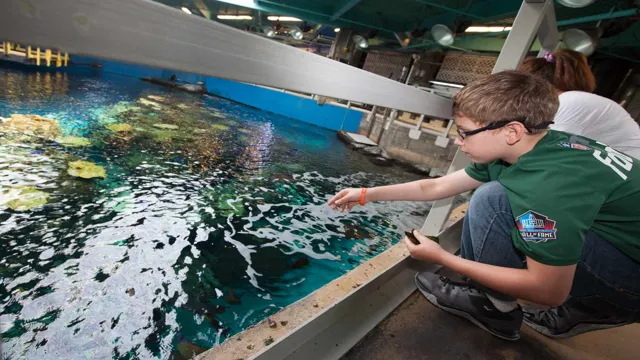Welcome to the fascinating world of aquariums! If you’re looking for a fun and educational activity, visiting an aquarium is a great choice. Whether you’re a family with kids, an animal lover, or a curious tourist, you’ll find lots to discover and appreciate in aquariums. But, how do you get to the aquarium? Don’t worry; we’ve got you covered! In this blog post, we’ll guide you through various ways to get to the aquarium and make the most out of your visit.
So, grab your backpack, put on your walking shoes, and let’s dive into the adventure!
Choose Your Transportation Method
When planning a trip to the aquarium, one of the first things to consider is your transportation method. Depending on your location and preferences, there are a few options to choose from. If you have your own vehicle, driving is a convenient choice.
You can park your car at the aquarium and avoid the hassle of finding a parking spot. However, if you prefer not to drive, public transportation is also a great option. Many cities have buses or trains that will take you directly to the aquarium.
Additionally, there are often taxi services or ride-sharing apps available for a more personalized transportation experience. No matter which option you choose, be sure to consider the distance, time, and cost of your transportation to ensure a stress-free and enjoyable trip to the aquarium.
Car/Taxi:
When it comes to getting around your destination, choosing the right transportation method can make or break your trip. For some, taking a car or taxi is the way to go. This gives you the convenience of being able to go wherever you want, whenever you want.
It also allows you to save time by avoiding crowded public transportation. However, it can also be more expensive, especially if you’re traveling alone or going a short distance. Additionally, traffic and finding parking can be a headache in crowded urban areas.
Ultimately, it comes down to your personal preferences and the specifics of your trip. Are you on a tight budget? Is parking easy to come by? Are you traveling with a group? These are all factors to consider when deciding on whether to take a car or taxi. Whatever your choice, make sure to weigh the pros and cons carefully to ensure a smooth and stress-free journey.

Public Transportation:
Public Transportation is an affordable and convenient way to get around the city. When choosing your transportation method, it’s important to consider your options and make the best decision for your needs. Whether you’re commuting to work or exploring the city, there are many options to choose from.
Buses, trains, and subways are all great options for getting around, depending on your location and destination. Some buses even have dedicated lanes, reducing travel time and making public transportation a faster option. But public transportation isn’t just limited to traditional methods.
Many cities now offer bike-sharing programs, allowing riders to pick up and drop off bicycles at various locations throughout the city. These programs are perfect for short trips around town and can be a great alternative to driving or taking a taxi. Regardless of which mode of public transportation you choose, it’s important to plan your route in advance.
Many cities offer online maps and schedules, making it easy to plan your trip and get to your destination on time. And don’t forget to take advantage of any discounts or promotions that may be available for frequent riders. With so many options available, there’s no reason not to take advantage of public transportation in your city and enjoy a more affordable, eco-friendly way of getting around.
Check Operating Hours and Admission Fees
If you’re planning a trip to the aquarium, it’s important to check the operating hours and admission fees ahead of time. Many aquariums have varying hours of operation depending on the day of the week or time of year. Some may even have special events or maintenance closures that can affect their regular hours. (See Also: How to Break Down an Aquarium: Step-by-Step Guide for Efficient Maintenance)
As for admission fees, these can also vary greatly between different aquariums. Some may offer discounts for certain groups, such as students or seniors, while others may have different prices for adults versus children. It’s always best to check the official website of the aquarium you plan to visit for the most up-to-date information on their hours and fees.
By doing so, you’ll be able to plan your visit accordingly and avoid any surprises or disappointment upon arrival. So, before you head to the aquarium, don’t forget to check those hours and admission fees!
Operating Hours:
If you’re planning a trip to a museum or an art gallery, it’s important to consider the operating hours and admission fees beforehand. It can be frustrating to arrive at your desired destination, only to find out that it’s closed or the fees are more than you anticipated. So, before heading out, take a moment to visit the museum’s website or give them a call to check the details.
Many museums offer discounted or free admission on certain days of the week or during specific hours. This can be a great way to save money on your visit while still being able to enjoy the exhibits. Keep in mind that peak hours and holidays may come with higher prices or longer wait times.
If you’re traveling with a group, be sure to inquire about group discounts as well. Overall, being aware of the operating hours and admission fees can help you plan a better trip and avoid any unnecessary headaches.
Admission Fees:
Operating hours and admission fees are key considerations when planning a visit to any attraction. It’s always a good idea to check the official website or social media channels for the most accurate and up-to-date information. Most attractions operate on a schedule, so it’s helpful to know in advance what days and times they’re open.
Additionally, admission fees can vary greatly depending on the attraction and the age group of visitors. Some attractions offer discounts for children, students, seniors, and military personnel, while others may have special deals for groups or seasonal promotions. It’s important to weigh the cost of admission against the value of the experience to ensure a satisfying visit.
To make the most of your time and money, be sure to arrive early and plan accordingly to avoid crowds and long lines. By doing a little research ahead of time, you can enjoy a stress-free and memorable experience at any attraction.
Tips for Your Visit
If you’re wondering how to go to the aquarium, there are a few tips that can help you make the most of your visit. First, it’s important to plan ahead and check the aquarium’s hours and ticket prices before you go. Many aquariums offer discounts if you purchase your tickets online in advance, so be sure to take advantage of those savings.
Once you arrive, be sure to take your time and explore all of the exhibits. Many aquariums have interactive exhibits and hands-on activities that can be a lot of fun for both kids and adults. Additionally, be sure to check the schedule for any special shows or events that may be happening during your visit.
Finally, don’t forget to bring a camera to capture all of the amazing sea creatures you’ll see during your time at the aquarium. With these tips, you’ll be well on your way to having a great time at the aquarium!
Plan Your Visit in Advance:
If you’re planning to visit a new place, it’s always best to plan your trip in advance. Proper planning can make a world of difference, especially if you’re visiting a popular tourist destination. Here are some tips for planning your visit. (See Also: How to Increase Oxygen in Reef Aquarium: Tips and Techniques for Better Tank Health)
First and foremost, research the place you’re visiting. Find out about the local customs, cuisine, and tourist hotspots. This will help you make an informed decision on where to stay and what activities to do.
You can check travel blogs and forums or read reviews on popular travel websites to get an idea of what to expect. Book your accommodation in advance. This will save you the hassle of searching for a place to stay after you arrive.
You can compare prices and amenities and choose the best option for your needs. Plus, booking in advance may help you snag a good deal. Make a list of the activities you want to do and places you want to visit.
This will help you make the most of your time and not miss out on anything important. You can also plan your itinerary accordingly and allocate time for each activity. Finally, be prepared for any unforeseen circumstances.
Pack accordingly and carry all necessary documents, such as your passport and travel insurance. You can also keep a backup plan in place in case of any emergency. In summary, planning your visit in advance can make your trip stress-free and more enjoyable.
Bring Necessary Items:
When it comes to visiting a new place, it’s essential to have all the necessary items with you. Whether you’re heading to the beach, the mountains, or a bustling city, packing the right things can make or break your trip. So, what should you bring? Firstly, you’ll want to ensure you have all your essential documents, such as your passport or ID, travel itinerary, and any necessary visas.
Beyond that, it’s always a good idea to bring a first-aid kit, sunscreen, and insect repellent, especially if you’re spending time outdoors. Don’t forget to pack comfortable shoes, a reusable water bottle, and a map or guidebook to help you navigate your surroundings. If you’re traveling in colder weather, be sure to pack warm clothes and layers.
Bringing items that make you feel comfortable, like a favorite book or playlist, can also help make your trip more enjoyable. Remember, while it’s important to pack wisely, don’t overpack. Try to keep it light and focus on the essentials so that you’re not weighed down by heavy luggage or struggling to carry too much.
By bringing the right items, you can ensure that you’re prepared for anything and ready to make the most of your visit.
Enjoy Your Trip to the Aquarium!
If you’re looking for a fun family-friendly activity, a trip to the aquarium is always a great choice! Depending on your location, there may be several aquariums to choose from, so be sure to research the one that is closest to you. Once you have chosen your aquarium, it’s time to plan your trip. Check online for information about prices, hours of operation, and any special events that may be happening.
You don’t want to show up to find out that the aquarium is closed or fully booked! Consider buying tickets in advance to avoid long lines. When you arrive at the aquarium, take your time exploring all of the exhibits. Don’t be afraid to ask questions or interact with the staff- they are happy to help and share their knowledge. (See Also: How to Drill an Aquarium and Install an Internal Overflow: A Step-by-Step Guide)
Be sure to bring a camera to capture all of the amazing creatures you will see, and if you have kids, encourage them to participate in any educational or interactive activities. Going to the aquarium can be a truly immersive experience, so make the most of it and have fun!
Conclusion
So you want to go to the aquarium? Easy fish-easy, my friend! All you need to do is follow these simple steps: pick a fun group of fish-loving buddies, don’t be koi about asking for directions, follow the current of excitement all the way to the entrance, sea all the amazing exhibits, and remember to take a shell-fie! With these tips, you’ll be swimmingly successful in your adventures to the aquarium. Happy “fishing”!
FAQs
What is the address of the aquarium?
The address of the aquarium is [insert address here].
What are the opening hours of the aquarium?
The aquarium is open from [insert opening hours here].
How much is the entrance fee for adults?
The entrance fee for adults is [insert fee here].
Is there a discount for children or seniors?
Yes, there is a discount for children and seniors. [Insert discount details here].
Are there guided tours available in the aquarium?
Yes, guided tours are available. [Insert tour details here].
What kind of marine life can be found in the aquarium?
The aquarium houses a variety of marine life such as [insert list of marine life here].
Can visitors touch or feed the marine animals?
No, visitors are not allowed to touch or feed the marine animals for their safety.







